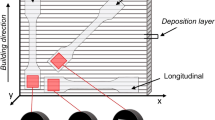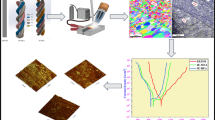The Moldavian Metallurgical Plant has made a study of dynamic strain aging by subjecting specimens of wire rod made of steel Sv-08G2S to tension. Some of the steel had been microalloyed with boron, while another portion was made without this element. A stable reduction in strength properties was seen nearly throughout this range (the only exceptions were the increases in σu and Δσu in the boron-free wire rod for a test temperature of 350°C). There were some differences in the temperature dependences of ψ of steel Sv-08G2S made with and without boron. For the boron-bearing steel, the high values of ψ (77–80%) in the temperature range 200–450°C – the range that poses the greatest danger from the standpoint of reducing process ductility in drawing – in fact give the rod excellent ductility for deformation. Relatively low values of ψ are seen for the boron-free steel in the range 200–450°C. Wire rod made of steel Sv-08G2S (with or without boron) is characterized by a multiphase structure, and its matrix contains not only polygonal ferrite grains but also evenly distributed colonies of pearlite, bainite, and martensite. The stable decrease in strength properties at 100–150°C is connected with redistribution of the stresses between the structural components of the steel. Additional studies will be needed to explain the relatively stable level of ψ of boron-bearing steel Sv-08G2S wire rod in the range 200–450°C.
Similar content being viewed by others
References
I. I. Novikov, Theory of the Heat Treatment of Metals [in Russian], Metallurgiya, Moscow (1978).
V. K. Babich, Yu. P. Gul, and I. E. Dolzhenkov, Strain-Aging of Steel [in Russian], Metallurgiya, Moscow (1972).
V. P. Fetisov, Strain-Aging of Steel During the Drawing of Wire [in Russian], Belgorstankinpromizdat, Minsk (1996).
V. V. Parusov, A. M. Nesterenko, I. V. Derevyanchenko, et al., “Structure and properties of wire rod and wire made of continuous-cast steel 70 microalloyed with boron,” Proc. Sci. Conf: Fundamental and Applied Problems of Ferrous Metallurgy, Naukova Dumka, Kiev (1998), pp. 383–388.
V. V. Parusov, A. B. Sychkov, A. M. Nesterenko, et al., “Mastering the production of wire rod and rod made of high-quality boron-microalloyed medium-carbon steel cast into semifinished products of small cross section,” Metall. Gornorud. Prom., No. 4, 48–51 (2000).
A. B. Sychkov, Development of an Integrated Technology for Producing Efficient Types of Wire Rod from a Continuous-Cast Semifinished Product of Small Cross Section with a High Content of Nonferrous-Metal Impurities and Nitrogen: Engineering Sciences Doctoral Dissertation: 05.16.01 and 05.16.02, Minsk (2005).
A. M. Nesterenko, A. B. Sychkov, S. Yu. Zhukov, and V. I. Sukhomlin, “Fine-scale microstructure of wire rod made of high-ductility steel Sv-08G2S,” Metallurg, No. 9, 48–51 (2008).
Author information
Authors and Affiliations
Corresponding author
Additional information
Translated from Metallurg, No. 6, pp. 61–64, June, 2009.
Rights and permissions
About this article
Cite this article
Nesterenko, A.M., Sychkov, A.B., Sukhomlin, V.I. et al. Changes in mechanical characteristics during the strain-aging of wire rod made of steel Sv-08G2S. Metallurgist 53, 362 (2009). https://doi.org/10.1007/s11015-009-9167-7
Received:
Published:
DOI: https://doi.org/10.1007/s11015-009-9167-7




